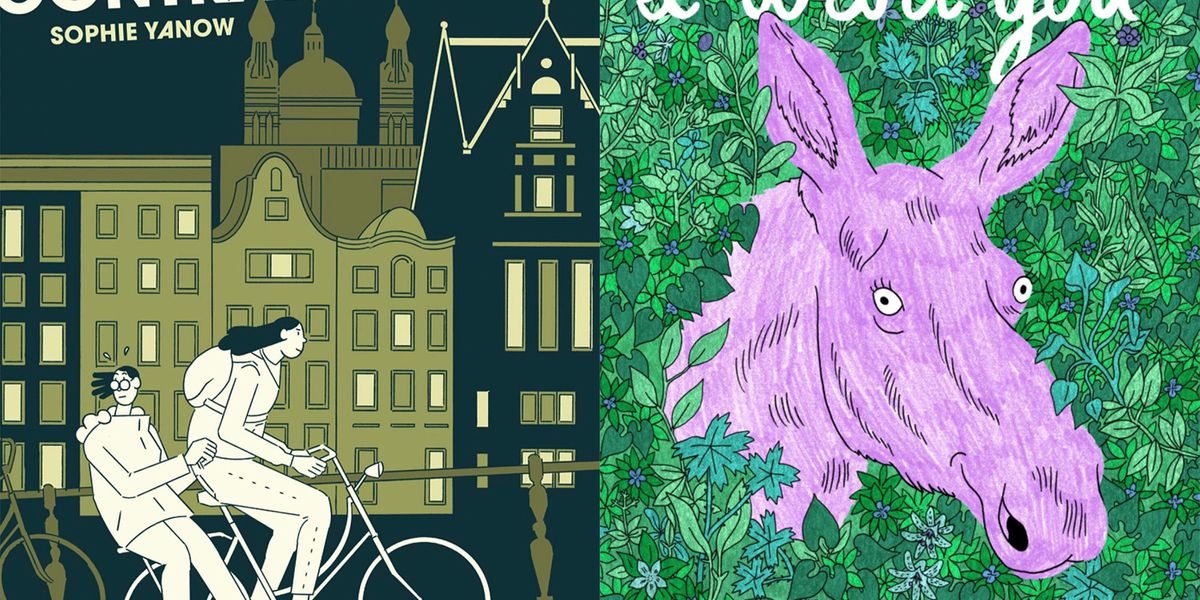“Cartoon” can mean a lot of things. As a drawing style, those things usually include simplification. A cartoonist takes a massively detailed real-world subject and extracts the most defining elements and reproduces them through a few well-placed lines. The cartoonist also probably alters those lines, distorting them by selectively expanding and shrinking to create shapes that evoke but don’t match the original content. How simplified and how distorted offer wide spectrums, and every artist’s style is its idiosyncratic cross-point on that simplify-distort grid.
Look at the works of Sophie Yanow and Lisa Hanawalt. Both are renowned cartoonists, each with new graphic novels (Yanow’s The Corrections and Hanawalt’s I Want You) released a month apart by their publisher Drawn & Quarterly, but their styles occupy very distant locations in what they show to be the vast world of cartooning.
Yanow is a minimalist. Her protagonist—a younger version of herself in college—consists of a small repeating set of identical marks. Her eyes are the circles of her glasses perched on the tiny circle of her nose. Her mouth—sometimes a straight line identical to the straight lines that represent the stems of her glasses, sometimes a slightly curving smile or frown, and sometimes just a perplexed dot—does all of the work of expressing her limited emotions.
Her body is even more geometric, elbows and knees often at right angles or undifferentiated in the straight lines of her straight limbs. The proportions are pleasantly odd too, her head a little too small, her torso a little too big, though not so exaggerated that she departs from a feeling of improbable naturalism.
The rest of Yanow’s world obeys the same simplified laws of reality. Some settings are evoked by even fewer lines, each the same unaltering thickness as the frame lines surrounding them. Yanow doesn’t draw a single crosshatch in her entire 200-page memoir. Either a shape is opaque black or empty white. Her layouts are equally consistent: six squares arranged in three rows of two. The few variations (white spaces replace panels during the final train ride home and when Yanow is finally alone and decompressing) are some of the most evocative moments in the memoir.
(courtesy of Drawn and Quarterly)
Hanawalt is a maximalist. Her protagonists—many of whom have animal heads but human bodies—consist of intricate patterns of fur and clothing, offset by comparatively sparse but equally intricate shapes that define their surroundings. Her crosshatching is often meticulous, giving realistic depth and texture to the characters’ exposed heads and limbs and so intensifying the surreal effect. When Hanawalt leaves the interior of shapes unshaded, the pages resemble absurdist coloring books inappropriate for humans of any age.
Where Yanow champions blocky consistency, Hanawalt wanders through multiple layout variations. Some pages are single images, some are partitioned into single-line frames, others into gutters, and still others are entirely open-framed. Her rendering style roams just as freely, from thin-lined black to gray washes to opaque grays. While most of her lines are sharply precise, a few pages feature thicker looser art, as if an uncredited guest artist dropped by. Most are clearly Hanawalt-esque, though unexpected undertones of Shel Silverstein and Phoebe Gloeckner stroll through too.
Hanawalt’s free-roaming styles are well-suited to her collection, which (as her bird-headed cartoon self explains in the introduction) compiles her pre-animation (BoJack Horseman, Tuca & Bert) minicomics from 2009 and earlier. Though some characters recur (She-Moose and He-Horse get top billing), most are an anonymous cast of oddball humans and half-humans muddling through early 21st-century existence. Though Hanawalt’s humor makes things a little more surreal (list of invented dances, instructions for pretending to jack-off while driving, things you can do nightmarishly wrong in grocery stores), but the baseline reality is uncomfortably familiar.
(courtesy of Drawn and Quarterly)
Though Yanow’s reality is explicitly real—The Contradictions documents a European hitchhiking trip she took while studying abroad—its unrelenting layout and style norms suggest the confused rigidity of her younger self as she struggles to navigate a paradoxically unpredictable world. Where Hanawalt is inventing a hybrid world to reflect on ours, Yanow’s younger self seems trapped in her own 3×2 gridded mindset which inaccurately partitions her experiences. She is a quietly unreliable visual narrator, unaware that her mismatched traveling companion and their awkward inability to relate is the source of her gently tragic disconnection.
Both cartoonists are drawing self-portraits, Hanawalt indirectly, Yanow explicitly. Their bodies and so their sexualities are part of their imagery. Yanow’s 20-year-old self is openly lesbian, but she doesn’t seem especially at ease with that fact—or possibly with any facts about herself. Though there’s no overt sexual tension between her and her kleptomaniac anarchist friend Zena, the rules of plotting imply it, even as Yanow’s rules of representation stifle the possibility through a kind of visual asexuality. The characters seem lost inside the flat geometry of their clothes and bodies. The genre is coming-of-age, which Yanow quietly thwarts by allowing her cartoon self so little room for growth.
Hanawalt, however, is overt in her 20-something sexuality. Where Yanow seems incapable of recognizing let alone expressing physical desire, Hanawalt’s title declares it as organizing principle. There are a few explicit sex acts (penis hula hoop, sexy real estate brokers, children’s dinosaur porn), but the grainy texture of animal fur surrounded by delicately patterned clothes implies what otherwise goes undrawn.
Hanawalt’s half-humans are animals all the way down. We all are. Though she sometimes channels the sexual exuberance of Julie Doucet or Fiona Smyth, Hanawalt’s surreal bodies are also horror-tinged, often vomiting inexplicable clumps of noodles or baby chicks. The most disturbingly powerful sequence is She-Mouse’s visit to a surreal abortion clinic.
Despite their considerable differences in genre, style, and character temperament, Yanow and Hanawalt explore the same inexplicable underworld of longing, Yanow from the terrifying entry point of her 20s, and Hanawalt from the ravaged exit point of hers. Wanting and contradiction abound in both.




